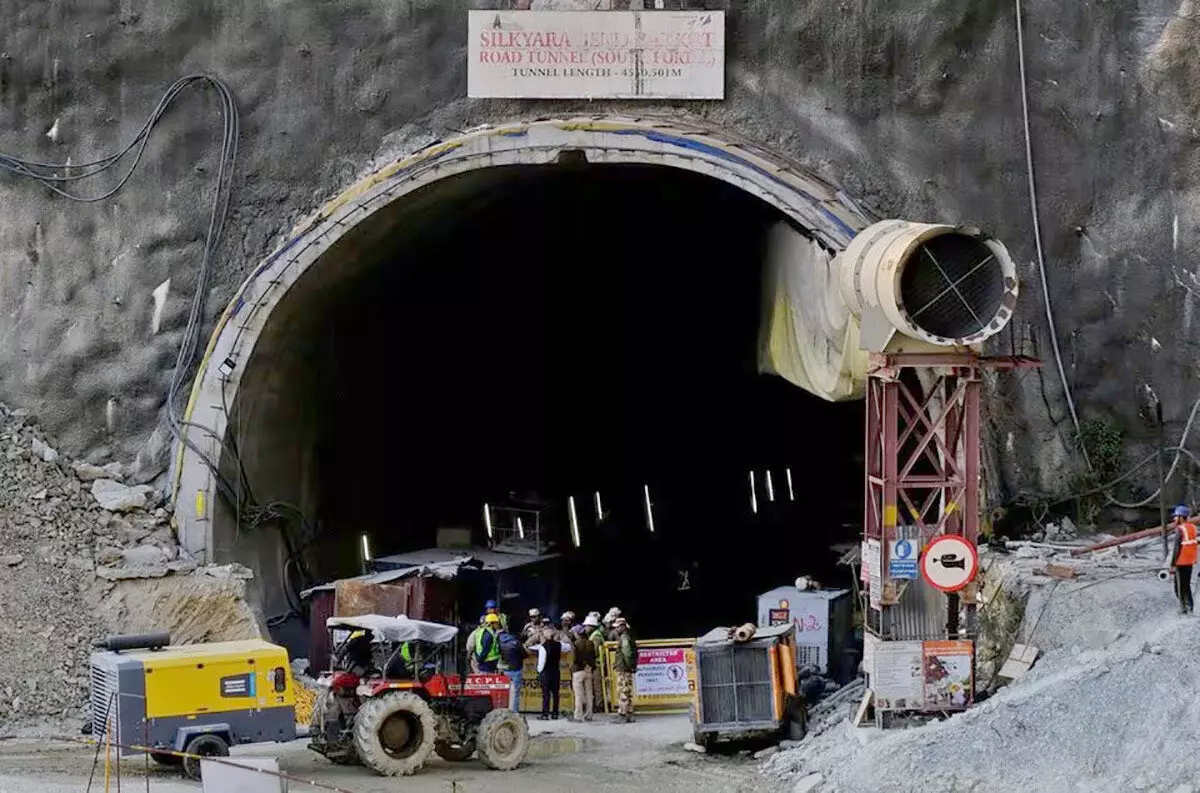Uttarkashi tunnel rescue: How banned rat-hole mining makes way to trapped workers
The workers were trapped after an under-construction section of the tunnel collapsed on November 12
By Sri Lakshmi Muttevi
Uttarkashi: As the 41 trapped workers emerged from the Silkyara-Barkot tunnel in the Uttarkashi district of Uttarakhand on Tuesday night, some with smiling faces and others looking grateful and exhausted at the end of the 17-day ordeal, the nation took a collective sigh of relief. They were trapped after an under-construction section of the tunnel collapsed on November 12.
Loud cheers and slogans erupted outside the tunnel as people greeted the ambulances that quickly transported the workers to community health centres while locals distributed streets. Anxious relatives who had been camping in the area were emotional as they were united with the workers after days of uncertainty.
Back home, many said they will now celebrate Diwali as the shadow of despair fallen on the families has disappeared.
Heroes behind the rescue
Did you know that a team of 12 rat-hole miners were brought from Delhi to drill the tunnel?
Yes! ‘rat-hole mining’ is banned, but it played an important role during the rescue operation. The National Green Tribunal (NGT) in 2014 imposed a ban on coal mining using the rat-hole mining technique in Meghalaya.
Rat-hole mining involves digging narrow tunnels, usually 3-4 feet high, for workers to enter and extract coal. The term ‘rat hole’ refers to the narrow pits dug into the ground, typically just large enough for one person to descend and extract coal.
Why was it banned?
Working in rat hole mines is a high-risk affair. The workers face a considerable chance of tunnels caving in, flooding, or being trapped without air, which can make them sick from breathing in coal dust and other harmful stuff.
This method of mining has faced severe criticism due to its hazardous working conditions, environmental damage, and numerous accidents leading to injuries and fatalities. Despite attempts by authorities to regulate or ban such practices, they often persist due to economic factors and the absence of viable alternative livelihoods for the local population.
At least 15 miners were killed in one such rat-hole mine in Meghalaya after being trapped for more than a month till January 2019 – one of the many tragedies in the state where rights groups say 10,000 to 15,000 have died in such mines between 2007 and 2014.
Even now, a few small mine owners continue to employ short people or children to illegally extract coal.
Meet the rat-hole miners
A National Disaster Management Authority (NDMA) member Lt Gen (retd) Syed Ata Hasnain said that rat-hole miners did a phenomenal job by digging 10 metres in less than 24 hours. “Rat-hole mining may be illegal, but it is the rat miners’ talent, experience and capability which was used,” he said.
At the Silkyara tunnel in Uttarkashi, at least 12 experts were called by Trenchless Engineering Services Pvt Ltd and Navayuga Engineers Pvt Ltd to deploy the rat-hole mining technique horizontally in the collapsed part of the main structure. They have come from Delhi, Jhansi and other parts of the country.
Miners crawled through 800 mm pipes
The rat-hole miners manually drilled their path to the trapped workers, a slow and difficult process in which they went one after another through the 800-mm diameter pipes laid through the rubble and removed the debris with the help of shovels to insert more pipes.
When asked whether going through the 800-mm diameter pipes would be difficult for them, a team member said they have experience in manually clearing debris through even 600-mm diameter pipes.
The rat-hole miners went inside the pipes wearing a helmet, a uniform, a mask and glasses. Though a time-consuming process, manual drilling was found to be a feasible option as only around 10-12 metres through the rubble remained to be drilled to complete the escape passage.
First reactions from trapped workers
Despite these challenges, poor pay, and exploitation, the rat hole miners were the ones who made a big difference during the Uttarkashi rescue.
NHAI member Vishal Chauhan explained that NGT has prohibited coal mining by that technique, going into tunnel kind of thing and getting coal out but this technique is still used in construction sites. “This is a special situation, this is a life-saving situation... they are technicians helping us,” he said.
Speaking to the media, Munna Qureshi, a rat-hole miner from Delhi who was the first person to reach the workers emphasised that he will forever cherish the respect bestowed upon him by the trapped workers.
A specialist in cleaning water and sewer systems, Munna was among the 12 rat-hole miners brought to Uttarkashi as the last line of defence after the US-made auger equipment malfunctioned. “They hugged us and lifted us, thanking us for bringing them out. We worked continuously in the last 24 hours. I can’t express my happiness; I have done it for my country,” said Munna.
Theives employ rat-holes?
According to a professor from the Department of Mining, rat-hole mining is also said to be used by thieves who steal coal. This is mostly seen in Chhattisgarh and Dhanbad where the miners enter the coal mines to steal coal using this process.